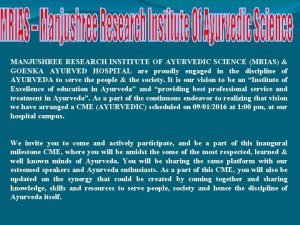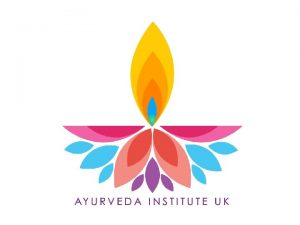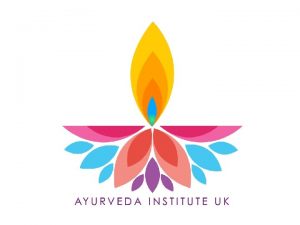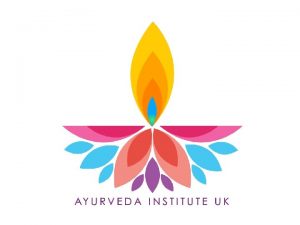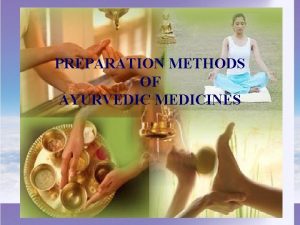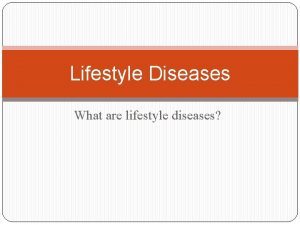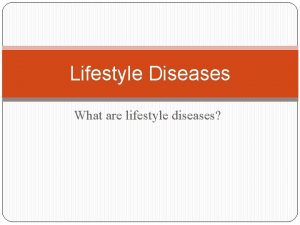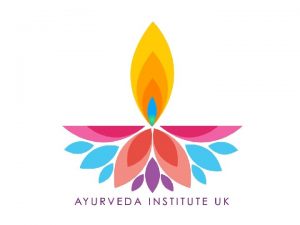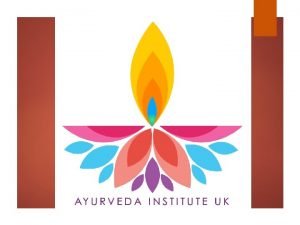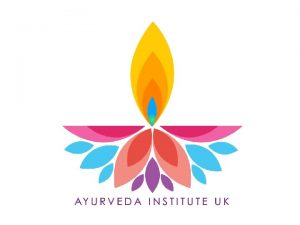DIPLOMA in Ayurvedic Lifestyle Nutrition Module 4 15

























- Slides: 25


DIPLOMA in Ayurvedic Lifestyle & Nutrition Module 4 15 th & 16 th December 2018 2

The Agnis Agni = enzymes The main task of agnis is to help: • digestion of food • assimilation of food This process takes place continuously in the body. There are 13 groups of agnis


Jathara-agni • 1 x Jatharaagni (Jathara-agni) • active in the stomach and in the gastrointestinal tract. • helps to break down the food taken from outside • food taken from outside has a different mahabhautic content composition than our body.

Pancha bhuta-agnis 5 x Bhutagnis (pancha bhuta agnis) • mainly housed in the liver • adapt the broken down food into homologous chyle • mahabhautic composition of the broken down food is now made into the same composition as that of the mahabhutas of the body • Post digestive diet is thus divided into the five groups to nourish the respective attributes of the body

Dhatu-agnis 7 x dhatuagnis (dhatu-agnis) • Enzymes that synthesize the dhatus (tissues) out of the ‘cooked’ (digested) food

Dhatu-agnis Tissue (dhatu) producing enzymes (agni) produce certain waste products in the form of excretions: • earwax, stool (from food, blood, waste • enzymatic action etc. ) • discharges from the nose, eyes, etc.

Ama and its formation • Ama = toxins • Diminution of agni (agni mandya) = formation of ama • Ama then settles down in different parts of the body, for instance - lungs, heart or any viscera. • Ama mixed with the doshas goes to the site of a manifestation of a disease, then signs and symptoms will manifest.

How ama causes disease • Diseases are invariably caused by ama • Ama affects the agnis • ‘Uncooked’ (undigested) food remains • Channels get obstructed

Ama and disease • Ama can get into any part of the body • Organs which accept ama easily – – Organ which is stressed and weakened – Organ similar in mahabhutic composition

The Seven Dhatus

Sapta Dhatus Dhatu comes from the root in Sanskrit, “Dha”which means ‘holding’ and so Dhatu means ‘that which holds’. • the basic tissue-elements • the seven bodily constituents

Stages of Dhatus 3 stages: 1. Stula – gross 2. Skshama - subtle 3. Mala – waste

Sloka “Prennanan jeevanan sheho dharana pourane garba uthpadanan kruthya”


Dhatu Nature Function (English) Rasa Plasma Preenana Nourishment Satisfaction Happiness Kapha Phlegm formed into faeces Rakta Blood Jeevana Enduring life Bile is formed into faeces Mansa Muscle Lepa Covering Adhering All excreta(eyes, ears, mouth) Medas Fat Sneha Lubrication Sweat Asthi Bone Dharana Support Hair Mjja Bone Marrow Purana Filling the cavity Glaze of the eyes Sukra Seminal Garba Uthpadana Production of fluid/reproduct embryo ive element Waste Product Beard or breasts, pubic hair

Srotas (Channels of Circulation)

Categories of Srotas • The body contains a large number of channels • Basic tissue elements or doshas and waste products circulate through these channels • These channels are called srotas or srotansi • Eg. Carrying products of food from the gastro-intestinal tract to the basic tissue element as nourishment

Table of Srotas

Name & Function. Anna vaha Srotas. (Carrying food which is taken from outside). Prana vaha Srotas. (Carrying vitality & breath). Controlling Organ. Causes of Vitiation. Signs & Symptoms. Untimely food, Loss of appetite excessively large (Anorexia, quantities of food, indigestion, unwholesome food, vomiting). less power of digestion. Heart & Alimentary Wasting, suppression Long, restricted, of natural urges, tract. shallow & frequent intake of un-unctuous breathing. (Asthma food, exercise whilst is connected with hungry. Stomach. Ambhu vaha Srotas. (Carrying water, fluid part of body). Palate, Pancreas. Rasa vaha Srotas. (Carrying chyle, lymph & plasma). Heart and ten vessels connected with the heart. Exposure to heat, indigestion, excess alcohol, intake of excessively dry food and excessive thirst. Worry, intake of excessively heavy, cold and un-unctuous food. this). Dryness of palate, lips, tongue and throat. Anorexia, nausea, heaviness, drowsiness, fainting, anaemia, impotency.

Name & Function. Controlling Organ. Causes of Vitiation. Rakta vaha Srotas. (Carrying blood, especially haemoglobin fraction of blood). Liver, spleen. Irritant, hot and unctuous food, excessive exposure to sun and fire. Mamsa vaha Srotas. (Carrying ingredients of muscle tissue). Tendons, ligaments, skin. Medo vaha Srotas. (Carrying ingredients of fat tissue). Kidneys, Omentum, (fat tissue in abdomen). Asthi vaha Srotas. (Carrying nutrient ingredients for bone tissue). Hipbone. Signs & Symptoms. Obstinate skin diseases, bleeding, abscesses, inflammation in the anus and genital organs. Sleeping immediately Granuloma, Myoma, after meals, frequent Piles, Uvulitis, Goitre, intake of heavy and Adenitis, Tonsillitis, gross food. many cancer types as well as nonmalignant growths. Lack of exercise, day Obstinate urinary sleep, (suppresses disorders, including enzymes & digestion), diabetes. excessively fatty food, alcohol). Excessive exercise Cracking nails and involving friction of teeth, pain in bones, intake of change in hair vatika type of food (because hair is (food producing excreta of asthi). vayu).

Name & Function. Controlling Organ. Causes of Vitiation. Signs & Symptoms. Majja vaha Srotas. (Carrying nutrients ingredients of marrow). Bones, joints. Pain in joints, giddiness fainting, loss of memory, blackouts, also deep abscesses. Sukra vaha Srotas. (Carrying semen and ovum and nutrient ingredients for these. Testicles, Contradictory (incompatible) food, injury to bone marrow by crushing, compression etc. Incompatible foods Sex at improper time, unnatural sex, suppression or excess of sex. Artava Vaha Srotas (Carrying semen and ovum and nutrient ingredients for these. Ovary. Sex at improper time, unnatural sex, suppression or excess of sex. Infertility, abortion defective pregnancy. Rajah Vaha Srotas. (Female reproduction) Womb Spicy food, alcohol, excessive sex Endometriosis, fibroids, excessive menses/bleeding, no menses, infertile Impotency,

Name & Function. Controlling Organ. Stanya Vaha Srotas. Breast, lacrymal ducts (Lactation) Purisha Vaha Srotas. (Faecal circulation) Colon Mutra vaha Srotas. (Carrying urine). Kidneys, bladder. Causes of Vitiation. Signs & Symptoms. Malnourished, incompatible food, emotions Lack of breast milk, mastitis, bad taste/odour of breast milk Unnecessary enema, anal sex, dry foods, alcohol, tenismus Constipation, incontinence, piles, anal fissure/fistula Food, drinks and sex during urge for micturition, suppression of urge for micturition, especially by those suffering from wasting. Sweda vaha Srotas. Fat tissue, hair ollicles. Excessive exercise, (Carrying Sweat). anger, grief, fear, exposure to heat. Excessive quantities or no urine. Frequency of urination, thick urine. Absence of or excessive perspiration. Roughness of skin. Horripilation (hair erection) burning sensation in skin.

Name & Function. Controlling Organ. Causes of Vitiation. Signs & Symptoms. Mano Vaha Srotas (Channel of the mind) Whole body Un-processed thoughts, nightmares, head injuries, lack of sleep, emotions Hallucinations, forgetfulness, depression, lack of co-ordination
 Diploma in modern dietetics and ayurvedic nutrition
Diploma in modern dietetics and ayurvedic nutrition Ayurvedic theory
Ayurvedic theory Manjushree research institute of ayurvedic science
Manjushree research institute of ayurvedic science C device module module 1
C device module module 1 Moodle lsmu
Moodle lsmu Sentences about healthy food
Sentences about healthy food Active lifestyle definition
Active lifestyle definition Acrostic poem life
Acrostic poem life Healthy lifestyle moodboard
Healthy lifestyle moodboard Firstbeat lifestyle assessment
Firstbeat lifestyle assessment Www.youtube
Www.youtube Lifestyle entrepreneur characteristics
Lifestyle entrepreneur characteristics Valstm
Valstm Athens vs sparta differences
Athens vs sparta differences Planning gaa
Planning gaa Lifestyle modern
Lifestyle modern Gaa lifestyle
Gaa lifestyle How are giraffes long necks adapted to their lifestyle
How are giraffes long necks adapted to their lifestyle Endocrinologist lifestyle
Endocrinologist lifestyle Now lifestyle autoresponder
Now lifestyle autoresponder Pangmukhang balita
Pangmukhang balita Lifestyle performance profile
Lifestyle performance profile Introduction to wellness and fitness
Introduction to wellness and fitness Unit 2 lifestyle
Unit 2 lifestyle Why do geographers call arabia a crossroads location
Why do geographers call arabia a crossroads location Atkins lifestyle
Atkins lifestyle


